
What is USDT? A Complete Guide to Tether
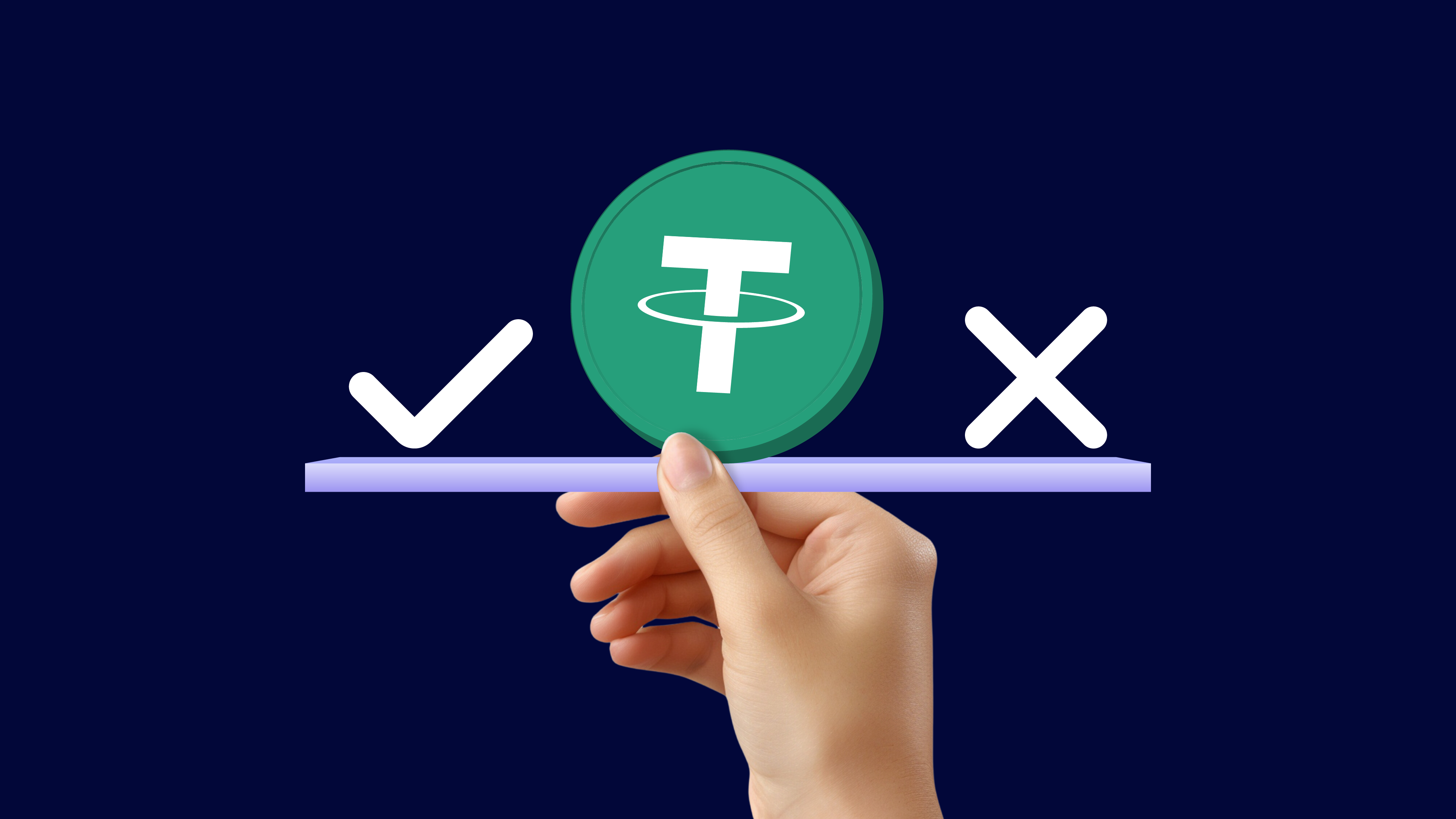
Tether (USDT) is the first successful “stablecoin”, launched by Tether Limited Inc. in 2014. It established the foundation for the essential infrastructure in modern cryptocurrency markets by creating a low volatility cryptocurrency asset.
Unlike other tokens with constant price fluctuations, Tether tokens are designed to maintain a stable value pegged to the U.S. dollar. This means 1 USDT token should always be worth approximately $1 USD.
In the last decade, Tether’s massive growth has led to its widespread compatibility on major blockchains. Despite a slow and controversial start, since March 2024, USDT became the third-largest cryptocurrency after Bitcoin and Ethereum, and keeps shifting places with XRP to solidify the importance of stablecoins in this sector.
While the initial novelty of a successful product can help it gain a foothold in its niche by setting the standard, how did it maintain that growth and stability to elevate the Tether token to a top 3 position? What is USDT, and what makes it such a valuable bridge between cryptocurrency and fiat money? Let’s take a closer look.
Disclaimer: As USDT no longer meets EU regulatory requirements and is being phased out, now is a good time to consider switching to compliant alternatives like USDC.
Thinking of introducing crypto into your business? Create a CoinGate account and accept crypto payments right away.
What is USDT and how does it work?
Tether is intentionally designed to maintain the closest possible value to the US dollar, ensuring that 1 USDT always equals 1 USD. Tether Limited achieves this by keeping a reserve of US dollars that backs each USDT token issued.
Because of this dependable peg, USDT is far less volatile—just like the US dollar—but also outshines traditional currency with instant settlements, Blockchain integration, and DeFi compatibility. Tether stablecoin provides the reliability of fiat money, while maintaining the convenience of cryptocurrency transactions.
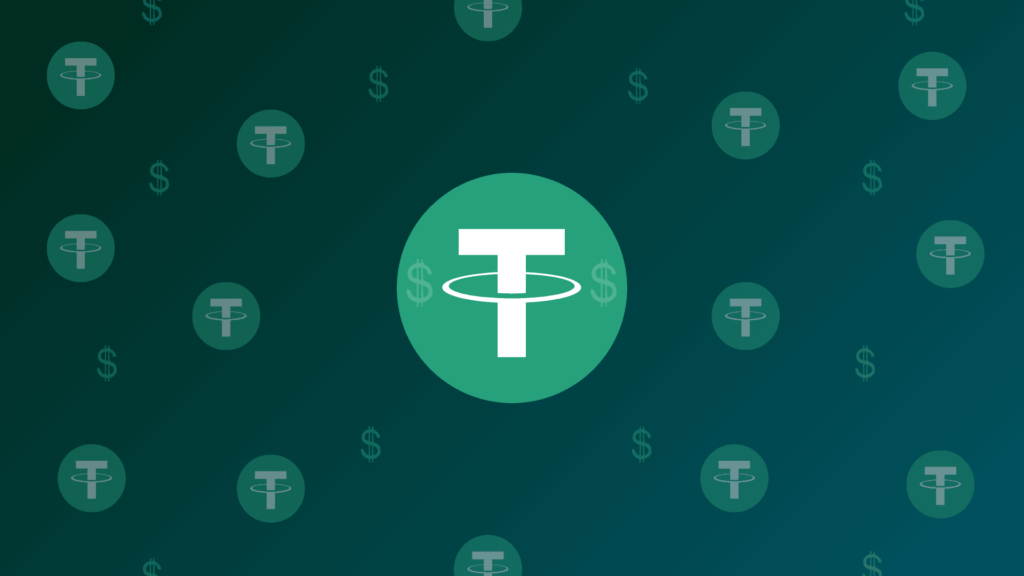
While USD is stable, natively digital currencies like tether tokens offer significant advantages for online operations due to their decentralization, speed, global accessibility, programmability, and transparency. Meanwhile, digitized fiat money relies too much on centralized control, leading to inefficiencies, no programmability support, unnecessary costs, and delays with cross-border payments. USDT embodies the stability of the US dollar without regulatory and geo-location constraints.
By merging a well established stability of USD with benefits of natively digital cryptocurrencies, Tether limited has developed an essential tool for all market participants, and its benefit is well depicted by its exponential growth in market capitalization. As of March 2025, it reached $144 billion, accounting for more than 62% of the entire stablecoin market share.
But aren’t these claims of stability in crypto too good to be true? The legal issues faced by Tether in 2019 did raise concerns about the quality of the USD:USDT peg. However, Tether’s efforts to enhance transparency and verify resulted in employment of the Proof of Reserves system, which verifies that all issued tokens are indeed backed by the necessary reserves. This system is designed to provide users with confidence in Tether’s ability to back all issued tokens through regular attestations from third-party accounting firms and public reporting of reserve compositions.
What is USDT Used for?
Traders and merchants utilize quick Tether token transactions to exit positions in the crypto market to a low volatility asset, as it can be sent directly between users’ blockchain addresses. Tether’s large market cap demonstrates its widespread adoption and usage compared to other stablecoins. However, unlike with other cryptos, Tether tokens are less suitable for speculative trading aimed at capitalizing on short-term price volatility.
Instead, they provide a quick exchange from volatile tokens to USDT for safekeeping to avoid price fluctuations. Nobody wants to experience the frustration of unwarranted losses, as transaction timing and price volatility can significantly impact the final amount received. Its stable nature makes USDT an ideal medium for moving funds between traditional fiat systems and the cryptocurrency market without the risk of losing value from market volatility.
During periods of high market volatility, Tether (USDT) serves as a valuable tool for traders seeking to mitigate risks. By converting their holdings to USDT, traders can protect their capital from sudden price drops, effectively managing their overall risk exposure. This stability allows investors to navigate turbulent markets with greater confidence and precision.
USDT is also widely adopted as a payment method. Our yearly crypto payments data report reveals that stablecoins accounted for 35.5% of all crypto payments in 2024, with USDT accounting for the vast majority of it. For comparison, in 2022, stablecoins accounted for only 16% of total payments made through our payment gateway. This figure rose to 25.4% in 2023 and today, ⅓ of all payments are made in USDT.
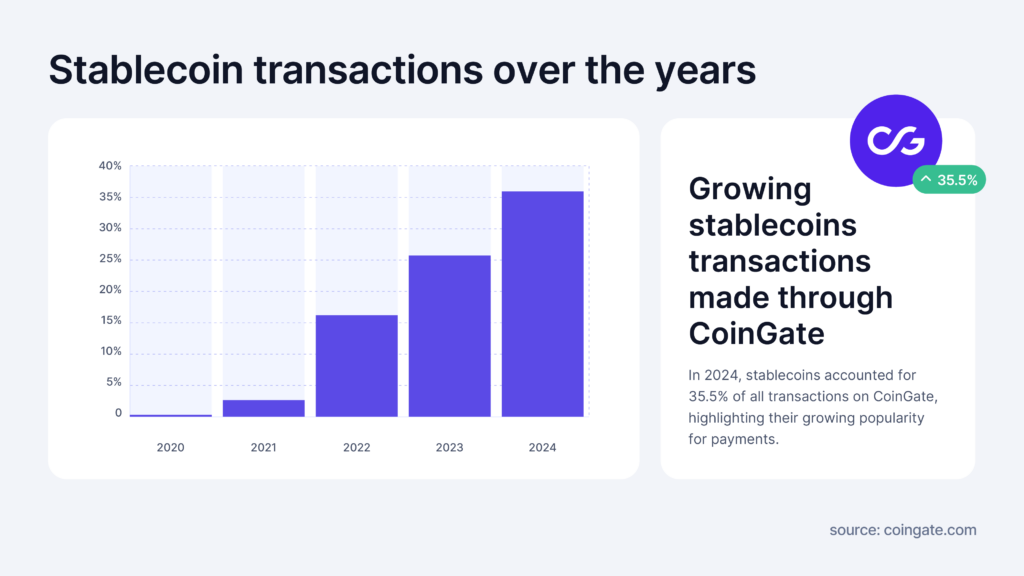
USDT achieves high liquidity through its widespread adoption across multiple platforms and blockchains. Its accessibility extends beyond just a few major exchanges, making it available on Binance, Kraken, Coinbase, and other trading venues. This broad reach has led to USDT becoming a go-to asset for cross-border transactions. Cryptocurrencies like Bitcoin and Ethereum can have significant price swings in short periods. Beginner traders benefit from using Tether to maintain stable value on cryptocurrency exchanges, especially with limited funds or when not actively trading. This protects profits from potential market downturns without having to fully cash out, as hedging protects the trader from unexpected crashes.
Tether maintains its full reserve backing through a combination of transaction fees, blockchain network usage charges, and interest earned on reserve assets. These sources generate sufficient revenue to support its market capitalization. The resulting high liquidity and wide acceptance make Tether tokens a fast and cost-effective option for international trades. As a necessary bridge between crypto and fiat money, USDT became an important part of the cryptocurrency ecosystem by facilitating benefits that market participants desperately needed.
Tether History: What does USDT stand for in Crypto
Tether Limited was founded in 2014 by Brock Pierce, Reeve Collins, and Craig Sellars under the name of Realcoin, after observing the volatility issue in other cryptocurrencies. Tether developed the stablecoin on Bitcoin’s Omni Layer protocol, working with banks and digital currency exchanges to establish the necessary infrastructure for buying, trading, and redeeming the tokens.
On October 6, 2014, the first Tether tokens were issued on the Bitcoin blockchain. The process of issuing tokens on Bitcoin’s blockchain is made possible through the Omni Layer protocol, which functions as a meta-layer built on top of Bitcoin’s infrastructure, and that’s how Tether got its start. Once the project kept evolving, the name was changed to Tether (USDT) in late 2014, when the company established its blockchain-enabled platform.
USDT Expansion to Other Blockchains
Until 2017, Tether relied solely on the Bitcoin blockchain’s basic transaction capabilities through the Omni Layer protocol, requiring more manual intervention and limiting integration possibilities. Tether implemented smart contract functionality through the Ethereum blockchain, and enabled USDT to work seamlessly with decentralized finance (DeFi) applications, lending platforms and trading pools, inviting more users to utilize smartcoins for safer exchanges making it easier for users to participate in the growing cryptocurrency financial ecosystem.
Having an asset like Tether on multiple blockchains provides users flexibility to implement its safety and convenience benefits to platforms based on their needs and preferences. In 2019, USDT continued to expand, making its way to Tron, Solana, Near, and OMG among others.
Same goes for our crypto payment gateway CoinGate – USDT is supported on multiple networks and layer 2 solutions, such as BNB Smart Chain (BSC), Tron, Polygon, and Arbitrum.
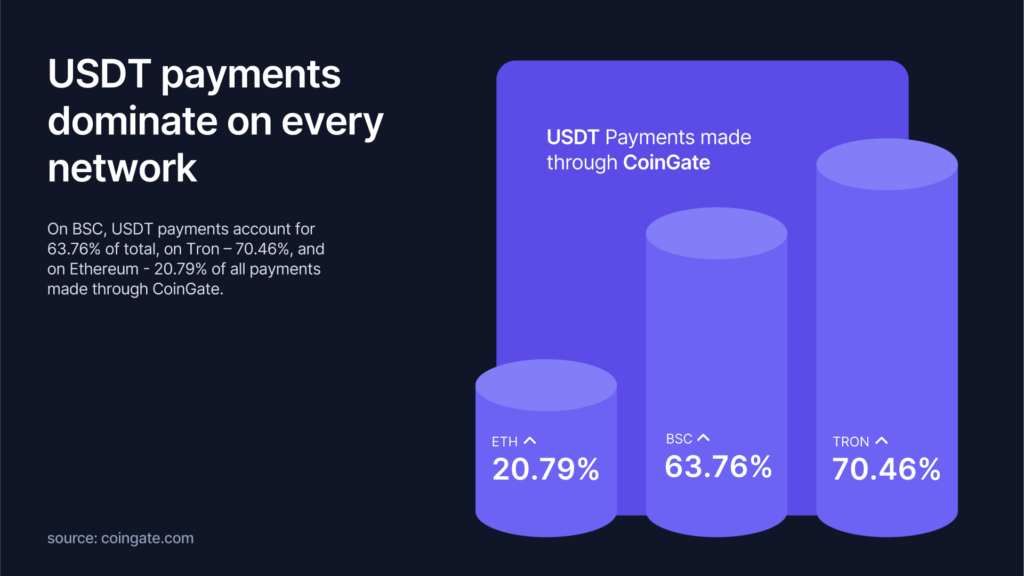
Tron came to be particularly popular amongst people who spend USDT for products or services – the majority of transactions on Tron via CoinGate were conducted using a USDT stablecoin, which accounted for 71% of its payments in 2024. The story is similar on the BSC network – in 2024, the majority, or 63.76% of all shopper payments were made using USDT.
The growth of Tether plays perfectly into its strengths, as multi-chain integration strategy enables exchanges to optimize transaction processing speeds and costs while maintaining operational flexibility across different blockchain ecosystems.
USDT Growth Period
Tether started growing real fast, with a 901% increase in trade volume as it kept expanding its integration into cryptocurrency exchanges, starting with Bitfinex enabling Tether trading on their platform in January 2015.
The stablecoin’s market presence surged dramatically as USDT’s share of Bitcoin trading volume experienced remarkable growth, reaching an unprecedented 80% dominance by the summer of 2018. This rapid expansion was marked by a particularly active period in August 2018, during which over $500 million in new Tether tokens were issued as the market demand kept rising until the first big hurdle in late 2018.
USDT Regulatory Issues
Amidst the growth and success of USDT, Bitfinex claimed the funds from Tether’s reserves were a loan to cover liquidity issues from their payment processor. However, the lack of disclosure around the transfer and Tether’s reserves raised concerns from regulators. In 2018, Tether borrowed $400 million to Bitfinex, a cryptocurrency exchange, while the movement of reserve funds threatened the entire stablecoin mechanism. As the investigation dragged on, a separate inspection from the U.S. Commodity Futures Trading Commission also found that Tether only had enough fiat money to back 27.6% of circulating USDT tokens.
Bitfinex claimed the funds from Tether’s reserves were a loan to cover liquidity issues from their payment processor, and argued it was a short-term liquidity arrangement that did not impact Tether’s backing. However, the loan sparked a big controversy. As the largest stablecoin, USDT’s stability is crucial for maintaining confidence in digital asset trading platforms, which led the New York Attorney General to start a regulatory enforcement action.
The reveal of undisclosed access to Tether reserves from a separate entity showed a lack of transparency and systems for risk management. People lost trust in Tether when they discovered money was moved from the reserve account without telling anyone, causing many investors to stop using USDT for trading. This led to fewer people buying and selling with Tether, making prices jump up and down more wildly and reducing the ease of converting between different cryptocurrencies.
After the investigation started by the NY Attorney General, Tether’s price dropped to $0.88 due to perceived credit risk. Traders on Bitfinex exchanged Tether for Bitcoin, driving up Bitcoin’s price. In 2021, the matter was resolved with a $18.5 million settlement. The companies agreed to enhance their reporting requirements and transparency measures. Meanwhile, the CFTC’s resolution was not a slap on the wrist – a $41 million penalty, exposure of poor reserve practices and misleading statements, and established regulatory supervision.
Changes in Tether Regulation and Transparency
Following the controversial settlement, Tether restored its reputation by implementing financial oversight by engaging independent accounting firms to provide regular assurance opinions verifying the authenticity of reserve holdings, and establishing detailed reporting requirements. The changes brought more transparency to USDT operations.
To further strengthen the trust of USDT users, Tether deployed sophisticated monitoring systems to prevent suspicious transaction patterns. They resulted in massive success by freezing $225 million in assets linked to human trafficking operations in Southeast Asia, and the identification of 326 suspicious wallets controlling about 435 million USDT. This enhanced AML infrastructure enabled real-time monitoring of transactions across multiple blockchain networks, reducing the impact of theft and transactions with malicious intent.
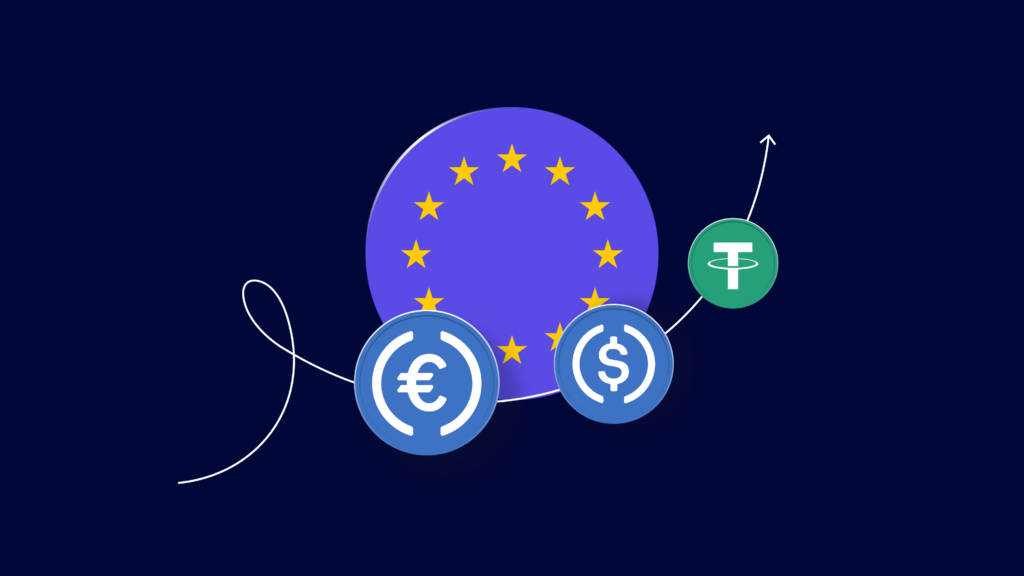
However, in Europe, UDST was affected by The European Union’s Markets in Crypto-Assets (MiCA) regulatory framework due to lack of compliance, and crypto service providers had to adjust their operations. For example, our team has also limited USDT services as currency conversion is no longer allowed, but businesses still can collect USDT payments, or use USDT for remittances.
If you’re interested in learning more about stablecoins, we recommend reading this article. Alternatively, you can create an account with CoinGate and start exploring your opportunities.
Recent Years
Tether’s recovery from regulatory scrutiny demonstrated remarkable resilience and the need for stablecoin existence. In fact, the token did not experience significant stagnation in the growth of its market cap. Meanwhile, improvements in compliance measures and proactive cooperation with regulatory bodies resulted in a strong resurgence. Tether kept expanding its Blockchain support and cross-chain compatibility, worked on development of new stablecoins, and most importantly – showed serious commitment to regulatory improvements.
A restored reputation led Tether to massive growth over the last 3 years, nearly doubling the market cap from $76 billion to $143.44 billion. The comeback of Tether can be attributed to improved adherence to regulations, or the market’s unshakable demand for a stablecoin – probably a mixture of both factors.
Summary
Over the last 10 years, Tether has established its non-negotiable importance in the cryptocurrency market, spearheading the importance of a stable, natively digital currency. The platform’s success stems from its ability to combine the benefits of the US dollar with the flexibility of crypto, pushing it to become the third largest cryptocurrency in the world. Through adoption of multiple blockchains and exchanges, USDT is the main contributor to the growth of the stablecoin market. If you’re ready to accept crypto payments, the best time is now.
Frequently Asked Questions (FAQ)
Is USDT a cryptocurrency?
Yes. While USDT is not volatile like other cryptos due to its pegging to the US dollar, it is classified as a cryptocurrency is determined by its underlying blockchain-based architecture and digital token structure.
What Blockchain is USDT on?
USDT operates across multiple blockchain networks, with primary implementations on Ethereum, TRON , Solana, and others, while also maintaining compatibility with additional platforms. The token’s multi-chain architecture and cross-chain interactions make USDT a respective token standard across many DeFI protocols and cryptocurrency exchanges.
What is Tether backed by?
USDT maintains price stability through market arbitrage mechanisms, where any deviation from its $1 peg creates immediate profit opportunities for traders to either buy undervalued or sell overvalued tokens, naturally restoring price parity.
What is Tether used for?
Tether provides a stable. natively digital currency that is not as volatile as other cryptocurrencies. Users can maintain the consistent value of their currency while enjoying instant settlements and international transactions without the infamous crypto volatility.
Accept crypto with CoinGate
Accept crypto with confidence using everything you need in one platform.

